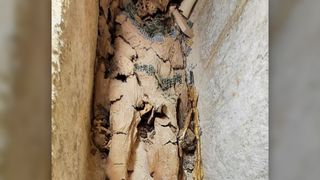Egyptian mummies covered in gold are rare, and we may have just found the oldest

The mummy of Hekashepes is seen here. He was buried covered with gold leaf in ancient Egypt. (Image credit: Courtesy of the Egyptian Ministry of Tourism and Antiquities)
Archaeologists in Egypt have uncovered a series of tombs dating back around 4,300 years at Saqqara, including a sarcophagus holding the oldest known ancient Egyptian mummy that is covered with gold.
The record-breaking tomb had a sealed sarcophagus containing the mummy of a man that a hieroglyphic inscription identifies as Hekashepes, and whose remains were found covered with gold.
“When the sarcophagus was examined, it was found to be completely sealed with mortar, just as the ancient Egyptians had left it 4300 years ago. When the lid was raised, we found the mummy of a man covered with gold leaf,” the team said in a statement posted on the Facebook page (opens in new tab) of Zahi Hawass, a former minister of antiquities who led the team that made the discoveries.
However, while other news outlets are reporting that this is the oldest Egyptian mummy known to archaeologists, that’s not the case. Rather, “This mummy is the oldest complete mummy covered with gold,” Hawass told Live Science in an email.
Many Egyptologists agree Egypt became unified around 3100 B.C., when the pharaonic state started. However, humans lived in the region as far back as 400,000 years ago. The oldest embalmed mummy in Egypt predates the pharaohs; the remains of a man who was placed in a fetal pose about 6,000 years ago. Meanwhile, the oldest known mummy in the world may be the 8,000-year-old remains of a man found in Portugal.
This sarcophagus belongs to a man named Hekashepes, whose mummy was found covered with gold. (Image credit: Photo courtesy Egyptian Ministry of Tourism & Antiquities)
There is little information about Hekashepes, but it appears that “he was wealthy,” Hawass said. Hekashepes’ mummy was mummified using artificial methods, is intact and is covered with gold. There are older ancient Egyptian mummies — such as several mummies that date back more than 5,000 years at the site of Gebelein, about 25 miles (40 kilometers) south of ancient Thebes (modern-day Luxor) — but those are not covered with gold.
According to images posted online of Hekashepes’ remains, it appears that his mummy is wearing clothes and doesn’t have bandages, Francesco Tiradritti (opens in new tab), an Egyptology professor at the Kore University of Enna in Italy who was not involved with these excavations, told Live Science in an email. The deceased seems like he was buried wearing a tunic with a belt and large necklace. This may be an attempt “to preserve as much as the living appearance of the deceased,” Triadritti said, something that might shine light on religious beliefs at the time this man died.
A number of statues were found in the newly discovered tomb. Some of them depict the tomb owners. (Image credit: Photo courtesy Egyptian Ministry of Tourism & Antiquities)
Tomb with paintings
Another important tomb belongs to a man named “Khnumdjedef” who was an “inspector of the officials,” who served the pharaoh Unas (ruled circa 2353 B.C. to 2323 B.C.), according to hieroglyphic inscriptions found in the tomb. His tomb was decorated with wall paintings depicting “scenes of daily life,” the statement said. One painting depicts five jars lined up on top of what looks like a table.
A wall painting found inside the tomb of Khnumdjedef, a man who was the “inspector of officials” hieroglyphic inscriptions say. (Image credit: Photo courtesy Egyptian Ministry of Tourism & Antiquities)
From a released photo, it appears that some of the paintings were drawn with “elongated proportions,” Tiradritti said. Paintings with elongated proportions became popular long after Khnumdjedef lived, during the First Intermediate Period (circa 2150 B.C. to 2030 B.C.), Tiradritti said. During the First Intermediate Period, a transitional time between the Old Kingdom and the Middle Kingdom, the region experienced a major drought, the central government in Egypt collapsed and the political structure changed.
The newly found paintings “are interesting to understand the evolution of [Egyptian art],” Tiradritti said.
More tombs
Another tomb found in the cemetery belonged to an official named “Meri,” whose hieroglyphic inscriptions say held a number of titles, including “keeper of the secrets” and “assistant of the great leader of the palace.”
Another tomb belongs to a priest, whose name may have been “Messi,” alongside his wife. It contains nine statues, some of which represent servants and one that represents the priest and his wife.
Additionally, the archaeologists found a shaft 33 feet (10 meters) deep that had a stone sarcophagus belonging to a man named “Fetek” at the bottom. He was buried along with three stone statues depicting him as well as an offering table.
From the information released so far, “it looks like the Egyptian mission found a necropolis that can be related to the pyramid of [Unas] and his cult,” Tiradritti said. Unas was the last king of the fifth dynasty and it’s possible that the newly found tomb may shed light on the transition between the fifth and sixth dynasties of Egypt, Tiradritti said.
After Unas died, a pharaoh named Teti (circa 2323 B.C. to 2291 B.C.), who was not a son of Unas and may have married into the royal family, came to the throne, starting the sixth dynasty. “The reasons for a changing in the royal line is still only a matter of guess,” Tiradritti said. The tombs may also help understand Egypt’s economy at this time, Tiradritti added, noting that Egyptologists usually see this as being a time of economic decline for Egypt.